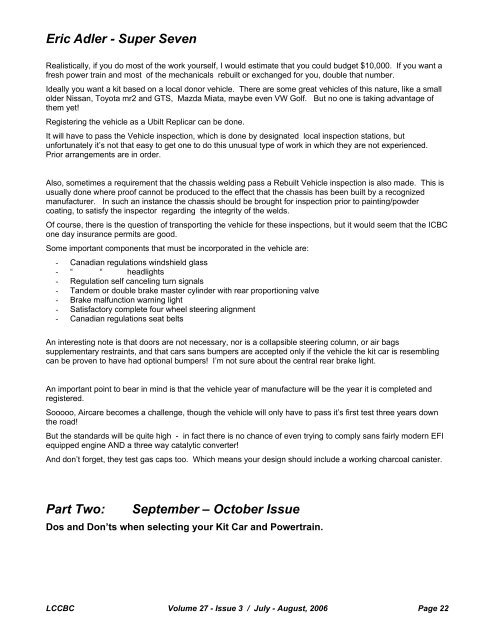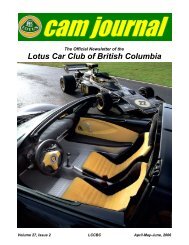Volume 27, Issue 03 Jul-Aug - Lotus Car Club of British Columbia
Volume 27, Issue 03 Jul-Aug - Lotus Car Club of British Columbia
Volume 27, Issue 03 Jul-Aug - Lotus Car Club of British Columbia
Create successful ePaper yourself
Turn your PDF publications into a flip-book with our unique Google optimized e-Paper software.
Eric Adler - Super Seven<br />
Realistically, if you do most <strong>of</strong> the work yourself, I would estimate that you could budget $10,000. If you want a<br />
fresh power train and most <strong>of</strong> the mechanicals rebuilt or exchanged for you, double that number.<br />
Ideally you want a kit based on a local donor vehicle. There are some great vehicles <strong>of</strong> this nature, like a small<br />
older Nissan, Toyota mr2 and GTS, Mazda Miata, maybe even VW Golf. But no one is taking advantage <strong>of</strong><br />
them yet!<br />
Registering the vehicle as a Ubilt Replicar can be done.<br />
It will have to pass the Vehicle inspection, which is done by designated local inspection stations, but<br />
unfortunately it’s not that easy to get one to do this unusual type <strong>of</strong> work in which they are not experienced.<br />
Prior arrangements are in order.<br />
Also, sometimes a requirement that the chassis welding pass a Rebuilt Vehicle inspection is also made. This is<br />
usually done where pro<strong>of</strong> cannot be produced to the effect that the chassis has been built by a recognized<br />
manufacturer. In such an instance the chassis should be brought for inspection prior to painting/powder<br />
coating, to satisfy the inspector regarding the integrity <strong>of</strong> the welds.<br />
Of course, there is the question <strong>of</strong> transporting the vehicle for these inspections, but it would seem that the ICBC<br />
one day insurance permits are good.<br />
Some important components that must be incorporated in the vehicle are:<br />
- Canadian regulations windshield glass<br />
- “ “ headlights<br />
- Regulation self canceling turn signals<br />
- Tandem or double brake master cylinder with rear proportioning valve<br />
- Brake malfunction warning light<br />
- Satisfactory complete four wheel steering alignment<br />
- Canadian regulations seat belts<br />
An interesting note is that doors are not necessary, nor is a collapsible steering column, or air bags<br />
supplementary restraints, and that cars sans bumpers are accepted only if the vehicle the kit car is resembling<br />
can be proven to have had optional bumpers! I’m not sure about the central rear brake light.<br />
An important point to bear in mind is that the vehicle year <strong>of</strong> manufacture will be the year it is completed and<br />
registered.<br />
Sooooo, Aircare becomes a challenge, though the vehicle will only have to pass it’s first test three years down<br />
the road!<br />
But the standards will be quite high - in fact there is no chance <strong>of</strong> even trying to comply sans fairly modern EFI<br />
equipped engine AND a three way catalytic converter!<br />
And don’t forget, they test gas caps too. Which means your design should include a working charcoal canister.<br />
Part Two: September – October <strong>Issue</strong><br />
Dos and Don’ts when selecting your Kit <strong>Car</strong> and Powertrain.<br />
LCCBC <strong>Volume</strong> <strong>27</strong> - <strong>Issue</strong> 3 / <strong>Jul</strong>y - <strong>Aug</strong>ust, 2006 Page 22






